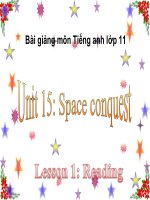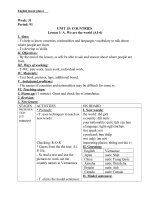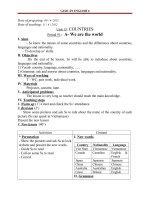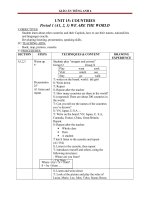Giáo án Tiếng Anh 11 unit 15: Space conquest
Bạn đang xem bản rút gọn của tài liệu. Xem và tải ngay bản đầy đủ của tài liệu tại đây (111.05 KB, 17 trang )
Giáo án tiếng anh lớp 11.
UNIT 15 :
SPACE CONQUEST
READING
Aims:
By the end of the lesson, students will be able to:
- scan read for specific ideas
- skim read for general ideas
Teaching aids: pictures, handouts
PROCEDURE
stages/
Activies
Interactions
Timing
Warmer 5 Quiz
T
Ss
mins
divide the class into two groups
prepare 6 questions beforehand to ask the two groups
Ss
Ss
Each goups takes turns to give answer to the questions
they hear. It they give the correct answer, they get one
mark. There will be a special question, and the group
giving the correct answer to this question gets three
marks . The group with more marks wins the game.
Questions:
1. What do we call someone invited to our house to
have a party?
(guest)
2. What is the popular website enabling you to search
for any information you need ? ( Google)
3. A kind of fruit related to the discovery of gravity.
(apple)
4. A small animal told in a fable to kill an elephant.
( ant)
5. An adj to describe the earth ( round)
6. What is the word to fill in this sentence ?
A friend in ......... is a friend indeed. ( need)
7. What is a small thing we need for making clothes ?
(needle)
Special question:
Can you use the first letter of 7 words above to make a
meaningful word ?
Key: GAGARIN
Declare the winner
Prereading
( 7 m)
Lead-in:
T
Are you the first Vietnamese person who set foot on
the moon ?
(Pham Tuan)
And Who was the first person in the world to set foot
on the moon ?
T
( Gagarin)
Yes, Gagarin, and today we are going to read about
this interesting person. In the first place, I'd like to help
you with some new words
Vocabulary
1. gravity ( n) - the pull of the earth.
2. cosmonaut ( n): translation
3. last (v): gap-filling
How long does this film ...........?
Expected answer: last
4. name after (v): context
This street was named after a Vietnamese writer.
What does named after mean ?
Expected answer: được đặt tên theo
Whilereading
( 8 m)
T
Ss
Checking
T asks Ss to work in pairs to complete the following
sentences with the words just learnt.
1. Pham Tuan was a very well-known ................in
Vietnam.
2. Water runs downhill because of ................ .
3. My school was ..................a national hero.
4. Our summer holiday often ...............about 3 months. T
Ecpected answers:
S
1.cosmonaut 2.gravity
3.named after
4.lasts
T says: Now let's get back to Gagarin, the first person
to come to the moon. Let's open your books to page
167 and read the reading text about him.
Activity 1: Matching Test
Instructions:
How many paragraphs are there in this reading text ?
( Five )
Ss
Ss
Ss
Ss
Ss
S
(10 m)
Good, and you see, each paragraph has a heading. Now
you read the text and then work in pairs to match the
headings to the paragraphs.
T
Suggested answers:
S
P1 - B (the lift-off)
P2 - E (Uncertainties)
P3 - D (A view of earth)
P4 - C (Congratulations)
P5 - A (The tragic accident)
T calls on some Ss to give answers.
T gives feedback.
Activity 2: Questions - Answers
Divide the class into groups of four.
Give handout (questions) to each group.
Asks Ss to read the text again and work in groups of
four to write their answers on the handouts.
Asks the groups to exchange the handouts for
correction
Calls on some groups to give the answers, asking each
group to correct the answers on the handout.
Ask each group to take its handout back after
correction.
Suggested answers
Post1. He became the first human being in space when he
reading
was 27.
( 10 m)
2. He was in space for 108 minutes.
3. Before his flight, these questions were raised
- What would happen to a human being in space ?
- How would the body react to the extreme changes in
temperature ?
- How would the mind deal with the psychological
tension ?
Homework 4. It was more than 17.000 miles per hour.
(2 m)
5. Because of a tragic accident.
6. After his death, his hometown of Gzhatsk was
renamed Gagarin, and the Cosmonaut Training Center
at Star City, Russia, was given the name to honour this
national hero.
S
S
T
S
S
S
T
Ss
Gap-fill
T asks Ss to read the reading text and then work in
pairs to do the gap-fill test (task 3/page 169)
T calls on some pairs to give the answers.
T gives feedback.
Suggested answers:
1.cosmonaut 2.lasted 3.uncertainies 4.gravity
5.view 6.chapter
7.impossible 8.symbol
Build the following sentences
1. Gagarin / not / get / home / if / there / technical
failure.
2. Although / flight/ last / no more / 2 hours / Gagarin /
become / greatest cosmonaut / all times.
3. U.S president John F.Kennedy / send / telegram /
congratulate / Gagarin / his feat.
4. Tragic accident / prevent / Gagarin / make / another
flight
Suggested answers
1. Gagarin would not have got home if there had been
a technical failure.
2. Although the flight lasted no more than 2 hours,
Gagarin became the greatest cosmonaut of all times.
3. U.S president John F. Kennedy sent a telegram to
congratulate Gagarin on his feat.
4. A tragic accident prevented Gagarin from making
another flight.
UNIT 15
SPACE CONQUEST
SPEAKING
Aims:
By the end of this lesson, Ss will be able to:
- ask and answer questions on given information
- talk about historical events in the space conquest
Teaching aids: pictures, handouts
PROCEDURE
Stages/Time
Activities
Interactions
Warm-up
What is it in the picture ?
T
Ss
( 5 m)
T shows a picture of a space-craft hidden by 4
Ss
Ss
numbered pieces of paper.
T prepares these four questions beforehand.
1. What is the missing word in this sentence ?
It only takes me about 1 hour to ..... from Hue to
HCM city.(fly)
2. Complete this sentence with a noun
Gagarin was a well-known .................. .
( cosmonaut)
3. Spacemen in the world have made progress
in .........( conquest).
4. What is the missing word in this sentence ?
Spacemen travel into space at great ...........( speed)
T divides the class into 2 groups, asking them to take
turns to choose the number on the piece of paper. For
each number, there is a question for them to answer.
If the members of the group give the correct answer,
that group has one mark and T takes off one piece of T
paper from the hidden picture . Ss can stop at any
time to tell what the picture is about, and if they get it
right, they score three marks for their group.
The group with more marks wins the game.
T
Hidden picture: SPACECRAFT
T declares the winner
Pre-speaking Lead-in: Today, we are going to talk about space
( 7 m)
exploration. First of all , I am going to provide you
with some new words.
Vocabulary
T
Ss
Ss
Ss
Ss
Ss
1.launch ( v) (gap-fill)
The first spacecraft was ............ into space in 1957
Expected answer: launched
2. mark (v) (translation)
3. human (n) (gap-fill)
Only h .............can use languageb to communicate.
4. orbit (n) (translation)
Whilespeaking
( 8 m)
(10 m)
Postspeaking
( 10 m)
Checking:
Rub out and remember
T
Ss
Activity 1: Questions-Answers
Intructions:
You are going to read a piece of news about manned
spacecaft of China, then work in pairs to ask and
answer questions about the text.
Example:
Student A: When did China launch its first spacecraft
into space ?
T
Student B: On Oct 15, 2003.
T goes around to offer help.
T asks some pairs to act out the aonversation.
T takes notes and gives feedback.
Activty 2: Group-work
Instructions:
Open your books on page 171 and have a look at the
events in space exploration of 8 different countries.
Now you have to work in groups of four. One
member of each group has to read about the space
exploration of one country carefully and then answer
any questions that the other 3 members may ask.
You have to choose the country by using a very
small paper ball . All you have to do is to drop the
ball onto page 171, and the ball falls on a country,
you have to talk about that country.
When you finish talking about the space exploration
of one country, move on with another one by
dropping the paper ball.
T goes around to offer help.
T
Ss
Ss
Ss
S
Ss
Homework
T takes notes of Ss' mistakes for indirect correction.
After 7 minutes, T asks them to stop and gives
feedback on their work.
Writing
Using the information given in box / page 171, write
a short paragraph about Pham Tuan, the first
Vietnamese person to set foot on the moon.
Copy your finished passage about Pham Tuan on
your exercise notebook.
UNIT 15
SPACE CONQUEST
LISTENING
Aims:
By the end of the lesson, Ss will be able to :
- listen for specific information
- listen for general ideals
Teaching aids: handouts, pictures
PROCEDURE
Stages/Time
Activities
Warm-up
Matching Game
T photocopies page 172 to make handouts for Ss.
T gives handouts to Ss and asks them to face them
down.
When all Ss already have the handouts, T asks them
to match the pictures with the descriptions at the
bottom of the handout. The first student who gives
the exact answers wins the game.
Key:
Picture A: 2
Picture B: 5
Picture C: 3
Picture D: 1
Picture E: 4
Declare the winner
Prelistening
( 7 m)
Lead-in:
What do you know about Apollo crew ?
(They first set foot on the moon)
Now look at picture A, how many people were there
in the crew ?
(There were 3)
Now today we are going to listen about this crew.
First I am going to help you know some new words.
Vocabulary
1. surface(n) ( drawing)
T draws the surface of the road, and elicits the word
surface
2. experiment(n) ( question)
What do scientists often do in laboratories ?
expected answer: experiment
3. astronaut (n): spaceman
4. challenge (n): (translation)
Interactions
T
Ss
Ss
Ss
T
Ss
T
Ss
Ss
Ss
T
S
Ss
S
Whilelistening
( 8 m)
Postlistening
(10 m)
Checking
T asks Ss to complete the following sentences with
the words just learnt
a. They couldn't walk on the moon's ...... unless they
wore spacesuit
T
b. Putting a man on the moon was a great ........... at
that time.
c. Mr Smith is doing his ............. in the chemistry lab
.
d. He was the first ............ to reach the moon.
Activity 1:
Instructions:
As I have said, this time you are going to listen about
the Apollo crew, who first reached the moon. Listen
and work in pairs to decide if the statements are true
or false. Remember that the tape will be played
T
twice.
S
T gives Ss handouts of T-F test
T plays the tape twice
T calls on some Ss to give the answers.
T goes over the answers with the class.
suggested answers: 1.F 2.F 3.F 4.F 5.T
T
Activyty 2: Gap-fill
T gives Ss handouts of activity 2
Instructions: Now listen to the listening text again
and answer the questions in the handout. You will
listen to the tape twice.
T gives Ss 1 minute to read the questions.
T plays the tape twice
T calls on some Ss to give the answers
T goes over the answers with the class.
Suggested answers:
1. NASA's Apollo program wa developed to meet
President Kennedy's challenge.
2. The Apollo 11 was launched on July 16, 1969.
3. The portable life support system was used for
controlling the oxygen temperature and pressure
inside the spacesuit.
S
S
S
S
Ss
Homework
( 2 m)
4. The astronauts stayed on the surface of the moon
they performed
a variety of experiments and collected soil and rock
samples to return to Earth.
6. They returned to Earth on July 24th, 1969.
Discussion
Choose one of the following topics and discuss it in
pairs
1. If you knew you had only one more week to live
on Earth because you would go to the moon and
stayed there forever, what would you do on those 7
days ?
2. If you had a chance to go to the moon and could
take only 3 things with you, what would you choose
and why ?
Writing
Write a short paragraph about this topic:
In your opinion, why do people take interest in other
planets in the solar system ?
UNIT 15
SPACE CONQUEST
WRITING
Aims:
By the end of the lesson, Ss will be able to:
- write a biography
- work in pairs / groups effectively
- do the tasks set by T correctly
Teaching aids: handouts, pictures
PROCEDURE
Stages/Time
Activities
Warm-up
Lucky Number
( 5 m)
Divide the class into 2 groups
T draws a flower with 9 petals and writes a number
on each petal.
T T asks each group to take turns to choose a number
and answer the following questions. The group with
more marks win the game.
1. Something we give our friend on their birthday
( gift)
2. A popular kind of drink in Japan, China and
Vietnam. ( tea)
3. Something that gives energy to the earth everyday.
( sun)
4. A synonym of crazy. ( mad)
5. name of an animal which has 2 letters. ( ox)
6. LUCKY NUMBER
7. a small, black animal living in the field ( rat)
8. The opposite of shake ( your head) ( nod)
Pre-writing 9. Fill in this gap " Don't cry over spilled ........ "
( 7 m)
( milk)
T declares the winner
T asks who can use all the first letters of those 8
words to write the name of a famous man.
Key: AMSTRONG
Lead-in:
In today's lesson, you are going to write the
biography of AMSTRONG. First i will provide you
with some new words.
Vocabulary
1. disaster ( explanation)
Interactions
T
Ss
Ss
Ss
T
Ss
T
Ss
Flood, storm, earthquake ... are disasters. What does
disaster mean?
Quote (n) ( elicitation)
What do you call a section of an application form in
which you write important events in your life ?
( quote)
3. investigate ( v) ( gap-fill)
The police are i.........the case of bank robbery in our
village.
(investigate)
4. biography (n) ( translation)
Checking:
Rub out and remember
Activity 1: Close-test
Instructions:
You are going to read about Amstrong's biography.
After reading it, you have to work in groups of four
to put each of the headings in the box in the
appropriate blank.
T calls on five representatives of five groups
( chosen at random) to go to the BB to write down
their answer.
Suggested answers:
1. birth
2. place of birth
3. known as 4.
career 5. quote
Activity 2: Writing
T asks Ss to read Amstrong's biography again and
work individually to write a paragraph of Neil
Amstrong.
Ss write their work on their notebooks.
T goes around to offer help.
T takes notes of Ss' mistakes for indirect correction.
T calls on 2 Ss to go to the BB to write down their
work. T, together with Ss, finds out the mistakes and
corrects them.
T gives feedback on Ss' work.
T points out some common mistakes made by Ss
when doing this writing task.
T
Ss
Ss
Ss
T
Ss
S
Homework
2m
sample development
Neil Amstrong is an American astronaut. He is
known as the first person to walk on the moon. He
was born on August 5th, 1930 in Ohio. From 1949 to
1952, he worked as a pilot in the United States Navy.
Amstrong received his BS from Purdue University in
1955. In 1962 , he joined the Nasa astronaut
program. On july 20th 1969 Neil Amstrong beame
the first human to step on the's moon's surface.
Amstrong received his M.S from the University of
Southern California. He resigned from nasa a year
later and from 1971 to 1979, he taught at the
university of Cincinnati. In 1986, Amstrong was
pointed vice chairman of the committee that
investigated the Challenger shuttle disaster.
Amstrong is aslo well- known for what he said when
he stepped on the moon's surface. There's one small
step for man, one giant leap for mankind
T comes to Ss to encourage them to write
T collects some mistakes made by Ss for indirect
correction
T asks two Ss to go to the BBto write down their
work
T gives
Wtite your own biography, the quote should include ;
- time to go to elementary school ( where/ when to
go / name of the school)
- time to go to secondary school ( where/ when to
go / name of the school)
UNIT 15 :
SPACE CONQUEST
LANGUAGE FOCUS
Aims: By the of the end, students will be able to :
* diatingguish the 4 sounds / nt/, /nd/,/nO/, /ns/, /nz/
* know how to use the conjunctions both... and, not only.. but also either ...or,
neither ...nor
* know how to use cleft sentences in the passive
Teaching aids: handouts, pictures
PROCEDURE
Stages/
Activities
Interactions
Timing
Warm- up Find the other part of your life
T asks two students to volunteer to play the game. The
should be a boy and a girl
The boy will look at the board and the girl stands
behind the boy. They have to stand back to back
T explains that the boy will be asked five questions and
all he has to do is to nod or shake his head to express
his agreement or disagreement
T will write his answer on the board
Then T will ask the girl the same five questions, the girl
can say yes or no to answer. If the boy and the girl have
more than three same answers they will become couple
of the day
Questions
1. Can you swim?
2. Can you sleep 10 hours a day?
3. Can you play a sport?
4. Can you eat chocolate/
5. Can you sing very well?
T declares if they are a couple or not
Lead- in
Can you tell me another way to ask the above
questions?
(expected answers
Are you to swim/... sing well?)
PresentNow, let's open your books to page 175. Today, we are
ation 1 10 going to practice more about this grammar point
mins
Pronunciation
Prent-tion
2 mins
T write on theBb
went end mnth chance phone
T asks:
Who can pronounce these words?
(Ss stand up to say the words )
T corrects their mistakes if necessary
T asks Ss to play attention to ending sounds of the five
words
Went end month chance phones
/nt/ /nd/ /n0/ /chnce /nz/
T hangs this chart
/nt/ rent, tenant, dind't
/nd/ remind, warned, friend
/n0/ seventh, tenth fifth
/ns/ tense, glance, Florence
/nz/ learns, tones, Barnes
T reads the words aloud and asks Ss to repeat
- T ahngs this chart
A: Florence, Mr.Barns went on the tenth last month
B: Oh, I have warned you, haven't ? Did you pay the
rent ?
A: Only to the seventh
B: Only to the seventh?
A: Yes, and we have no chance to see him again. Is he
your friend ?
B: No, Mr.Barns is not my fiend and if he phones,
remind him that he must pay the rent to the end of the
month
A: Don't be so tense. We'll have a new tenant on the
thirteenth of this month
T reads the sentences aloud, then asks Ss to listen and
repeat after him
T calls on some Ss to read the sentences aloud,
correcting their mistakes if necessary
Lead- in
T shows a picture of a man running
T asks :
Could he run fast five years ago ? (Yes)
T writes on the BB
He could run fast 5 years ago
T shows a picture of a man whose leg was hurt but he
was running fast
T asks: Did his hurt ?(Yes)
T writes
His leg hurt but he wa able to run fast
T explains
Could: exprees and ability was/ were able to: express an
effort to do st
Ex 1
T asks Ss to open their books to page 176
T asks Ss to work in pairs to complete the sentences,
using could, could't or was/ were ( not) able to
1. was able
2. was able to
3. could
4. was able to
5. could 6. couldn't
Ex 2
T revises how to make tag questions
It is a nice day, isn't it ?
They are hungry, are they?
You live here, don't you?
You don't speak English, do you?
T asks Ss to do exercise 2/ page 176/ 177 in pairs
T goes around to offer help
T calls on some Ss to read their answers aloud
T corrects their mistakes if necessary
Suggested answers
1. It's a very expensive restanrant, isn't it ?
2. The film was great, wasn't it ?
3. She has a lovely voice, doecn't she?
4. It doesn't look good on me, does it?
5. You have had your cut, haven't you ?
Ex 3
T asks Ss to do exercise 3/ page 177 in apirs
T goes around to offer help
Homework T calls on some Ss to read their answers alound
2m
T corrects their mistakes if necessary
Suggested answers
1.... doesn't she?
2. .... haven't you ?
3.... wasn't it?
4. ... didn't we? 5. ...won't
we?
6. ...can't you
7. ... musn't it ?
Mistake Correction
Correct the mistake in each sentence below
1. The bus was crowed with people but finally I could
find a seat
2. She didn't able to find him although she had gone
everywhere
3. Iam not a fool, am nit I ?
4. It seems to me that she is very good at maths doesn't
it /
1. could
was able to
2. didn't
wasn't
3. am not aren't
4. deosn't it isn't she









